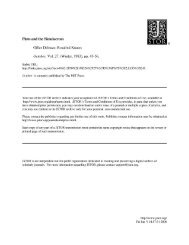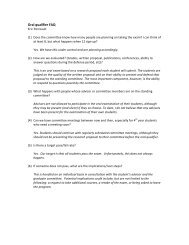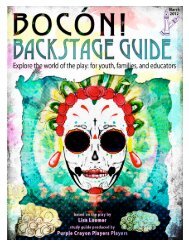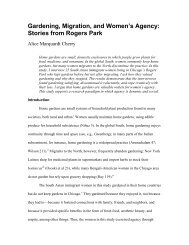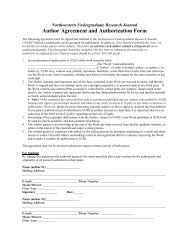research - Associated Student Government, Northwestern University
research - Associated Student Government, Northwestern University
research - Associated Student Government, Northwestern University
Create successful ePaper yourself
Turn your PDF publications into a flip-book with our unique Google optimized e-Paper software.
RESEARCHdegree of consideration if either prevention or diseasemanagement is to succeed. I will show why HIV/AIDSstrategies cannot follow a strictly biomedical solution,reveal the strengths that FBOs provide, and examineofficial Catholic policy on contraceptives. Through myvalidation of Catholic FBOs, whose beliefs appear themost problematic, I hope to simultaneously validate theparticipation and actions of FBOs from other religiousaffiliations.African Specific ObstaclesIt is essential to identify country specific behaviorsand beliefs that foster the spread of HIV/AIDS in orderto understand how to create successful prevention andtreatment plans.I. GenderIn sub-Saharan Africa women account for 60 percentof HIV/AIDS cases. 5 African societies “encouragethe abuse of women … [and] view sex as male conquest”which creates a greater need to provide supportdirected towards marginalized women. 6 When combatingpoverty and starvation, women are more vulnerableto contracting HIV/AIDS due to their increasedprobability of engaging in for-profit sex. 7 Biologically,women also face an added threat because of the increasedamount of surface area exposed on female’sgenitalia compared to male’s, the greater amount of semenpresent during sex compared to vaginal fluid, andthe increased amount of HIV in semen compared tovaginal fluids. 8 These social and biological factors helpto explain why HIV/AIDS affects women most severelyin sub-Saharan AfricaFurthermore, the migratory labor pattern in Africaincreases sexual concurrency and threatens traditionalfamilial units. 9 When combined with women’s socialstatus, the results are detrimental to African women’sability to protect themselves from HIV/AIDS. A studyamong Zambian women showed that “only 11% ofwomen believed that they had the right to ask their husbandsto use a condom.” 10 As a means for preventinginfection, condoms are not a complete solution, becausethey require the consent of the male sexual partner,women-controlled prevention techniques are needed. 11II. Scientific Model of HealingFor medical ailments, Westerners often look for ascientific explanation and derive a technical solution,whether it is a pill, vaccine, or surgery. 12 In many cases,physicians have achieved great success when implementingWestern healing to other contexts. It seemsonly natural that physicians follow a similar model forHIV/AIDS, with condoms providing the solution toprevention and antiretroviral drugs (ARVs) prolongingthe life of HIV-positive patients.However, medical approaches to HIV/AIDS differfrom other cases in biomedical healing because a curedoes not exist. ARV treatment requires lifelong treatmentthat is exponentially costly due to unpredictablefuture complications, whether disease remission or contractionof a different infection. This difference is crucialbecause Africans possess an inherent skepticism towardsa strictly technical model of healing. Historically,African models of healing encompass the total personwith “the real cause … in the social, religious realm.” 13Given a distrust of modern medicine, disease preventionmethods and chronic disease management proveproblematic. Regular condom use requires behaviorchange. Additionally, ARVs are more cumbersome thanone vaccination. Patients need to take medicine continuously,visit their local hospital and clinic, and possiblyattend continuous counseling. This new, endlessmethod of medical treatment appears like a completelyforeign process.III. Cultural Obstacle to TreatmentMany African patients completely avoid diagnostictesting and treatment. In part, this may result frompoor healthcare access, but it also results from culturalbeliefs and the stigmatization of HIV/AIDS.Most diseases merely shorten one’s life or impairproper bodily functioning. HIV/AIDS is more deadlybecause it also compromises one’s ability to produce aviable lineage. HIV/AIDS not only disrupts sex, a lifegivingprocess, it uses this process to transmit death. 14Thus, HIV/AIDS not only prevents one from producingtheir own offspring but also represents a failure to continuetheir ancestors’ legacy. Thus, an infected personwill not only suffer as an individual but will also havedetrimental effects on his community and its future.In Africa, a diseased individual traditionally representsthe physical manifestation of a disordered community,the result of unhealthy relationships among the livingor dead members of the community. 15 Africans mustquestion the foundation of their community in order todetermine the deeper significance. A sick communitymeans no cure and no hope for the future which makesHIV/AIDS highly stigmatized and feared. This fear maydeter many from seeking diagnosis.Africa’s history of colonialism and racial conflictalso discourage many Africans from seeking out medicalhelp and adhering to medical advice. Due to the sophisticationof medicine, the average African has no mannerin which to gauge the accuracy of the physician’sadvice. Their instinct, based on the knowledge of animperialistic past, ultimately influences their decisionsand serves to disrupt Africans’ trust of ARVs, medicinesdeveloped by foreign whites. 16 Because HIV/AIDS preventionand treatment require lifelong commitment andbehavior change to produce effective results, this distrust– whether slightly or deeply ingrained – decreasesthe likelihood that Africans will adhere to only modern14 NORTHWESTERN UNDERGRADUATE RESEARCH JOURNAL




